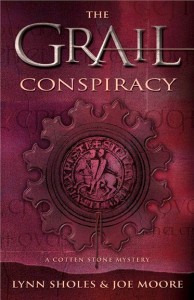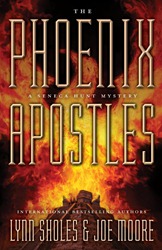By Joe Moore
 First, some shameless promotion. This Friday, August 24, Amazon will feature two of my thrillers (co-written with Lynn Sholes) on their Kindle Daily Deal. For one day only, you can download THE GRAIL CONSPIRACY or THE PHOENIX APOSTLES for
First, some shameless promotion. This Friday, August 24, Amazon will feature two of my thrillers (co-written with Lynn Sholes) on their Kindle Daily Deal. For one day only, you can download THE GRAIL CONSPIRACY or THE PHOENIX APOSTLES for  only $1.99 each. Both ebooks were featured on the Daily Deal in 2011 and made it to #1 on the bestselling Kindle book list. If you didn’t take advantage of the reduced price before, be sure to do so on Friday. Enjoy!
only $1.99 each. Both ebooks were featured on the Daily Deal in 2011 and made it to #1 on the bestselling Kindle book list. If you didn’t take advantage of the reduced price before, be sure to do so on Friday. Enjoy!
_________________
I recently read THE LOST ONES by Ace Atkins, a terrific story about a local county sheriff dealing with gun runners in North Mississippi. In addition to being an excellent storyteller, Atkins has an enviable talent for creating a strong sense of place—a vivid setting. By the time I finished the novel, I felt like I was so familiar with the back roads of Tibbehah County that I probably should be paying property taxes. And it gave me a big hankering for fried catfish, buttermilk cornbread and grits at the local diner.
So today I want to build on Joe Hartlaub’s Saturday post on Location and offer a few tips on creating a strong setting in your book.
Setting is integral to any story. As a writer, you’ve developed a unique plot and a strong set of characters. Now you must consider the setting. You can’t split the plot and characters from the setting and expect to produce a believable piece of prose in which your readers can relate. Why? Because like real life, your characters don’t live in a vacuum. Just like all of us, your characters are constantly affected by and reacting to their surroundings. For instance, how would your night scene be different if it took place in broad daylight? Rather than the scene being hot and dry, what if it was pouring rain? Would the weather and other natural elements change the dramatic impact of a scene? How would the setting make a scene spooky or funny or dangerous or calming?
Think of some classic scenes in your favorite books or movies and imagine them in different settings. Would they be as strong? Would Indiana Jones being chased down the streets of New York City by a big truck be as powerful as being chased by a giant rolling boulder through a cobwebbed ancient tunnel deep in the jungle? Would Clarice Starling’s interviews with Dr. Lecter have worked as well if it had taken place in a bright, modern chrome and shinny white prison rather than in the bowels of a dark, dungeon-like mental hospital for the criminally insane?
Beyond what your characters say and do, you must consider how their actions and reactions contrast or blend with their surroundings. And the best way to do that is to consider your setting as another character playing a part in the story. Setting is not just walls and doors and sky and grass, it’s how their surroundings interact with your characters, and their inner and outer actions and reactions to it.
Another element of setting is how characters live within it. By that I mean how they manage the common functions of life such as eating, sleeping, and other natural human processes. Most of us are familiar with the highly successful TV series 24. Even within the twenty-four-hour premise of each season’s show, people still had to take a deep breath once in a while. While 24 was a rare exception, most novels span more than one day. So during the course of the story unfolding, writers must manage their human characters with time to eat or sleep or at least rest for a moment. If the pace is so intense that the characters never get a break, the reader will become fatigued. Thrillers and mysteries are often described as rollercoaster rides. But even the longest coaster ride has peaks and valleys. Give your reader and your characters a break now and then by using the elements of the story’s setting.
And don’t forget about the passage of time as being an element of the setting. How does time passing speed up or slow down the plot or pacing? Is your story’s passage of time realistic? Or is it too compressed or expanded to be believable. Remember, unless you’re H.G. Wells and your book is called THE TIME MACHINE, be sure to manage your story’s clock so that it doesn’t get in the way of the story and give the reader a reason to pause and question it.
Setting is more than the location in which your story takes place. It’s all the external elements that affect your characters and their goals and objectives. If you treat your setting as an additional character, chances are your story will be fully developed.
Now let’s all go out for some fried chicken and collard greens.
How about you? Do you plan your settings ahead of time? Or let them develop as the story progresses. And readers, what was the most memorable and realistic setting in your favorite book?

Delighted you liked THE LOST ONES, Joe. More Tibbehah County coming in the spring!
One of the things I like about this blog is that not only I learn something valuable about the craft of writing, but I am introduced to new books (or is that two things I like about this blog?).
I ordered The Lost Ones right after reading this. Now, I am off to take a closer look at the weather in my WIP. Since it is a travel adventure, setting plays a HUGE part in my story. I like the idea of changing the weather to suit the mood of the scene.
Thanks, Joe!
Victoria Allman
author of: SEAsoned: A Chef’s Journey with Her Captain
http://www.victoriaallman.com
I’ll look forward to it, Neil. Thanks for dropping by.
Victoria, I’ve got my eye on Isaac, too. Looks like my house is right in the center of that storm’s path. I was wondering when our luck would run out. Could be by Sunday. Stay dry.
Good reminders, Joe. And I do think weather is an important adjunct to setting. It can do a lot for mood, tone, etc. We often hear the meme “Don’t start with the weather,” but that really refers to those that are merely descriptive. Mix it with how the character REACTS to it, and you’re fine.
I have read some memorable historicals lately where you feel like you are right in the setting. Reflections on the Nile by J. Suzanne Frank is one of them, and it takes place in ancient Egypt. I’ve just gotten hooked on C.S.Harris historical mysteries. They’re a lot of fun. You’ve given some great tips, Joe.
I will be tweeting your Friday treat, Joe.
Thanks, Jim and Nancy. Tweet on, Jordan.